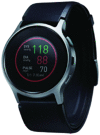Feasibility of Blood Pressure Measurement With a Wearable (Watch-Type) Monitor During Impending Syncopal Episodes
- PMID: 35929469
- PMCID: PMC9496316
- DOI: 10.1161/JAHA.122.026420
Feasibility of Blood Pressure Measurement With a Wearable (Watch-Type) Monitor During Impending Syncopal Episodes
Abstract
Background We assessed the reliability and feasibility of blood pressure (BP) measurements by means of a new wearable watch-type BP monitor (HeartGuide) in detecting episodes of hypotensive (pre)syncope induced by tilt table test. Methods and Results An intrapatient comparison between systolic BP (SBP) measured by means of the HeartGuide device and noninvasive finger beat-to-beat BP monitoring was undertaken both at baseline in supine position and repeatedly during tilt table test in patients evaluated for reflex syncope. Intrapatient fall of systolic BP from baseline was measured. Eighty-one patients (mean age, 61±19 years; 46 women) were included. Overall, HeartGuide was able to yield BP values at the time of BP nadir in 58 (72%) patients (average HeartGuide SBP 102±18 mm Hg, versus finger SBP 101±19 mm Hg). Compared with baseline, the maximum SBP decrease was on average -28.5±27.8 and -30.3±33.9 mm Hg respectively (Lin's concordance correlation coefficient=0.78, r=0.79, P=0.001). In the subgroup of 38 patients with tilt table test induced (pre)syncope, the average HeartGuide SBP during symptoms was 97±16 mm Hg, and the finger SBP was 94±18 mm Hg. Compared with baseline, the maximum SBP decrease was on average -35.2±29.3 and -43.3±31.8 mm Hg, respectively (Lin's concordance correlation coefficient=0.83, r=0.87, P=0.001). Conclusions Our data indicate that the HeartGuide BP monitor can detect low BP during presyncope and that its measure of SBP change is consistent with that simultaneously obtained through continuous BP monitoring, despite some intrapatient variability. Thus, this device might be useful in determining the hypotensive nature of spontaneous (pre)syncopal symptoms, a possibility that should be verified by field studies.
Keywords: blood pressure monitoring; finger blood pressure; syncope; wearable (watch‐type) monitor.
Figures





References
-
- Brignole M, Moya A, de Lange FJ, Deharo JC, Elliott PM, Fanciulli A, Fedorowski A, Furlan R, Kenny RA, Martiın A, et al. ESC guidelines for the diagnosis and management of syncope. Eur Heart J. 2018;2018:1883–1948. - PubMed
-
- Association for the Advancement of Medical Instrumentation . American National Standard: non invasive sphygmomanometers—part 2: clinical validation of automated measurement type; ANSI/AAMI/ISO. 2013:81060–81062. Available at: http://my.aami.org/store/detail.aspx?xml:id=8106002.
Publication types
MeSH terms
LinkOut - more resources
Full Text Sources
Medical

